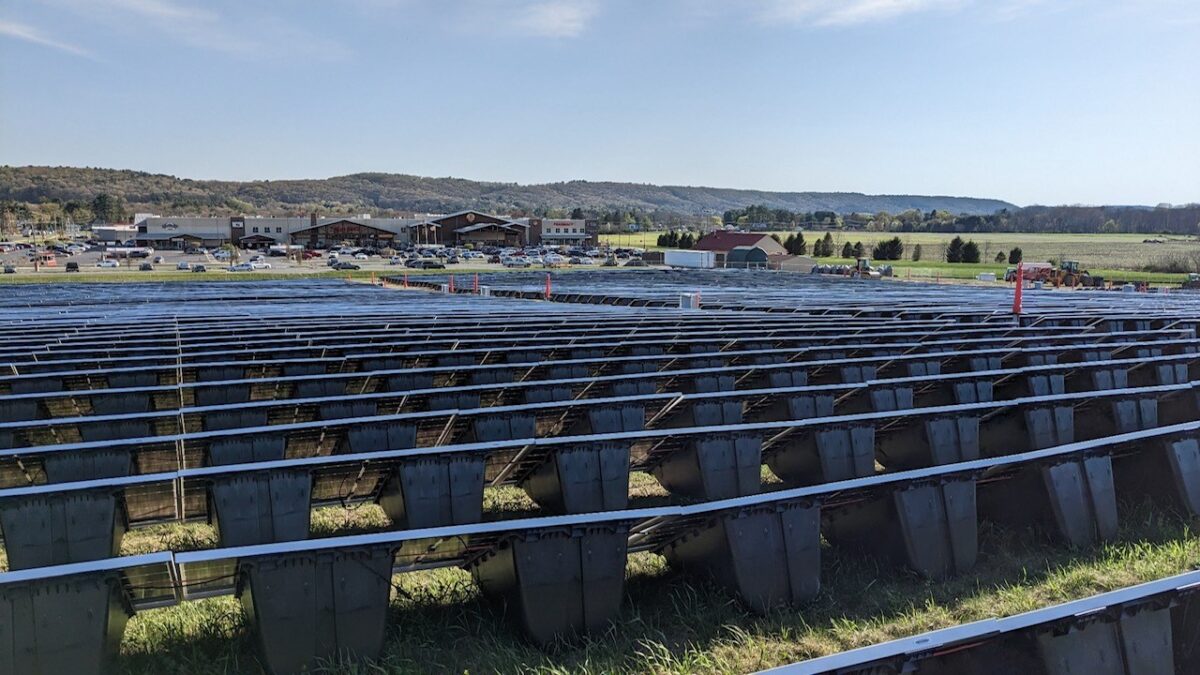An idea that began with PowerField Energy co-founders David Flory and Paul Burdick tinkering in a garage is now a growing company scaling up in production, funding and project pipeline. Both Flory and Burdick came from solar backgrounds and aimed to find a simple, low-cost racking solution. That tinkering led to development of the PowerRack, which is an injection-molded high-density polyethylene container that can be filled on site and used to mount solar panels of almost any size, no tools required.
pv magazine USA spoke with Drew Bond, co-founder and chief executive officer, Patrick Fleming, chief operations officer, and Corbin Abshier, director of business development, on the history of PowerRack. One of the first PowerRack installations was at the National Renewable Energy Lab in Golden, Colo., where they set up a two-year test model. To date, the company has installed PowerRacks supporting more than 4 MW of solar in residential and commercial as well as portable installations, like the one at this year’s Coachella music festival.
In seven years, the Virginia-based company has scaled production several times, has raised $1.3 million in funding and now is raising a Series A for $5 million to scale sales, manufacturing, and product development for global distribution.
In 2022 the company landed its first utility-scale contract for an installation in Brodheadsville, Pennsylvania where the developer, Endless Energy, had run into challenges around site conditions and environmental concerns and the developers couldn’t get the project across the finish line. The developer had already sunk a lot of money into the project, so they needed a solution that would get the project up and running as quickly and efficiently as possible.
Once the contract was signed, it was delayed for a year due to permitting issues, but once approved, the PowerRacks were installed, and modules mounted in four weeks. The project is at a ShopRite store, where 8,800 PowerRacks hold 4,400 Hanwha Qcells 480 W solar modules in the 2.1 MW system, powering more than 85% of the store’s energy needs.
According to Fleming, the site had underground water table issues and there was exploratory well equipment on the site that had to be avoided, so penetration with a traditional racking system was not going to work. The developer had already sunk a lot of money into the project, so they needed an inexpensive solution. The PowerRacks met their needs, and while the project was ten times larger than anything PowerField had done previously, they said they only needed to have one field employee on site to get the job done.

The racking is brought on site as empty 15-pound plastic containers, which are filled with any dry loose aggregate material such as gravel or crushed rock. The solar modules slide easily onto the racking and are held in place with clips. Clips are attached by hand, with no tools needed. When it’s time to decommission the solar installation, the modules are removed, the racking is emptied, and they can be removed from the site and recycled.
PowerRacks were also used to set up a temporary solar installation to power lighting the Coachella music festival held in April in Indio, California. Overdrive Energy Solutions chose the PowerRack after seeing them at a trade show and thinking their portability would meet their needs. Neel Vasavada, founder and president of Overdrive said a crew of four installed 15 kW of solar divided across ten locations.
“And we had never used the product before. We were down to 10 min. a location – less time than it takes to fuel a gasoline generator,” he said.
Once the festival was over and it was time to disassemble the temporary solar installation, Vasavada explained that “disassembly” doesn’t apply in the same manner as other products here.
“We used PowerRack specifically because there isn’t any disassembly of the racks themselves, except for picking up the plastic locking pieces after the panels are lifted off,” he said.
With the PowerRacks being portable and sitting above the ground, installers have a few options when it comes to handling the wiring. Fleming noted that there is a channel in the rack where the cabling rests along the sidewalls of the rack and up under the modules, just as it would with any system. The wiring can be run above ground with cable hangers or messenger cables, or the site can be trenched if that works better for the installation.
To date, PowerField has sold their racks in 38 states, with customers ranging from electric utilities to do-it-yourself homeowners. The company recently expanded its manufacturing capacity to meet the growing demand and PowerField is developing future versions of the PowerRack to accommodate ever-larger modules, different pitch angles and other unique customer requirements.
This content is protected by copyright and may not be reused. If you want to cooperate with us and would like to reuse some of our content, please contact: editors@pv-magazine.com.









This is a great idea. What I do not see in the company materials is an example of how these can be used on uneven terrain, where I would think it would provide a unique advantage. Allowing for shading, each rack can be set on ungraded terrain with a minimum of ground leveling for the base of the rack, and thereby the natural contours of the land can be maintained without destruction / disturbing the terrain.